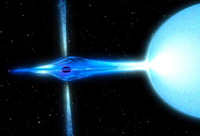AUDIO:
None.
VIDEO:
This video shows a black hole in a binary star system, with material from the blue giant star streaming towards the black hole. The gas in this stream orbits the black hole and forms a disk. Gas orbiting closer to the black hole moves faster than gas farther out. The gas heats up due to interaction of material moving at these different speeds, becoming hot enough to emit x-rays. Lines from the poles of the black hole represent jets of gas being ejected from the vicinity of the black hole at nearly the speed of light. How these jets form is poorly understood, but they are often seen near black holes accreting large amounts of material.
The gap between the gas disk and the black hole (near the end of the video) represents the innermost orbit matter can be in before plunging into the black hole. The radius of this innermost orbit depends on whether the black hole is rotating or not. If the black hole is rotating, material can orbit in more closely, causing the material to move faster than if the black hole is not rotating.


